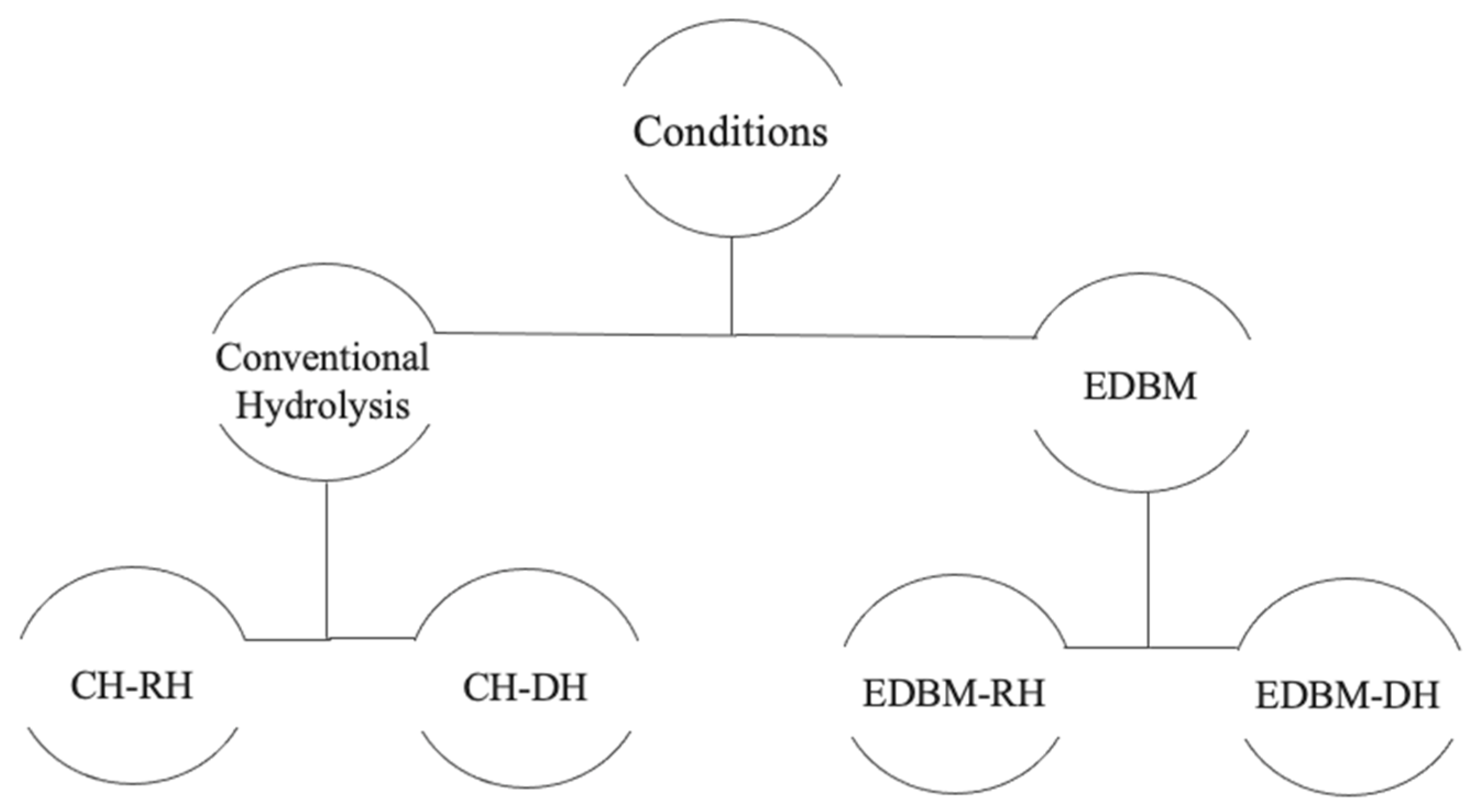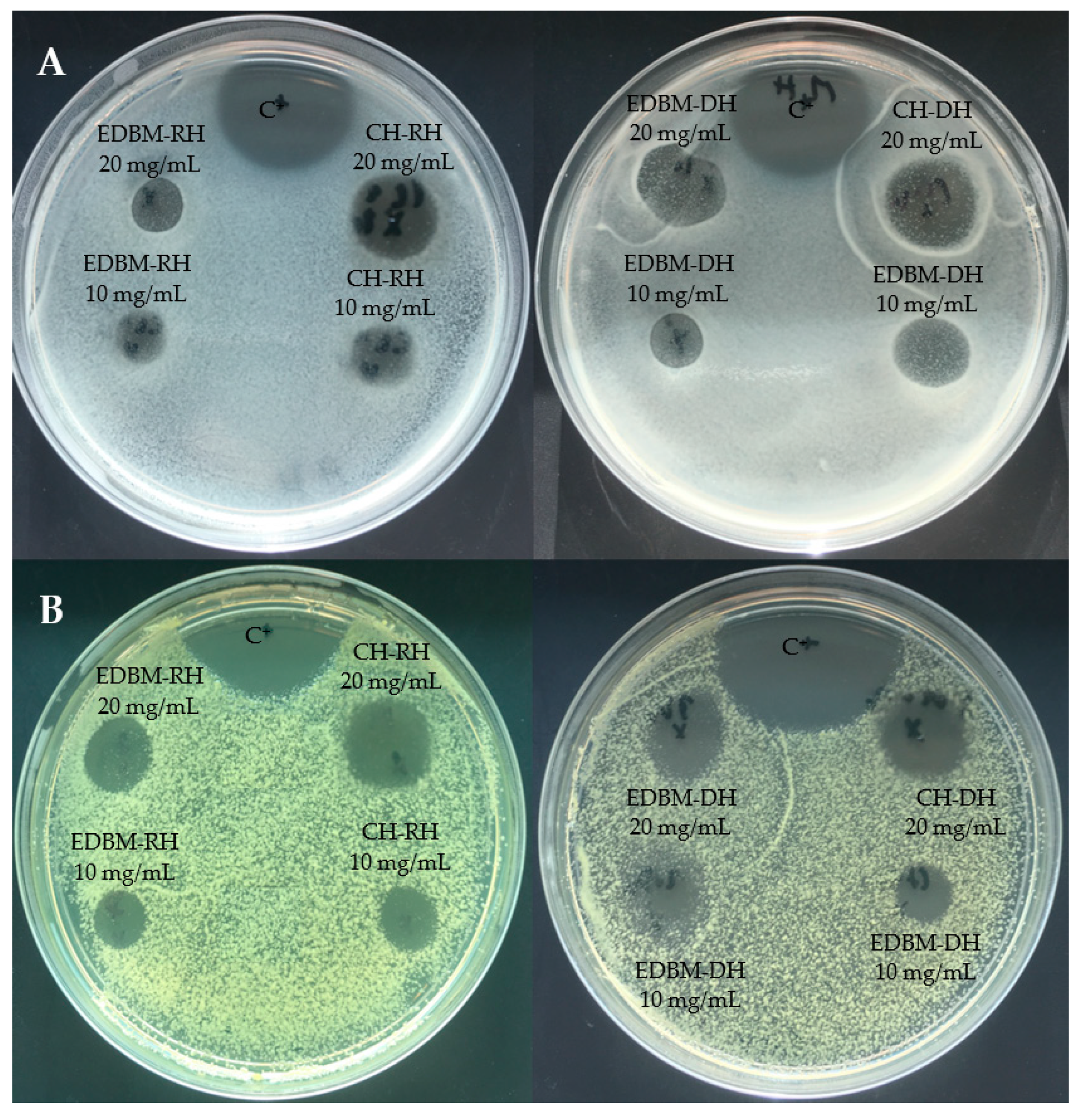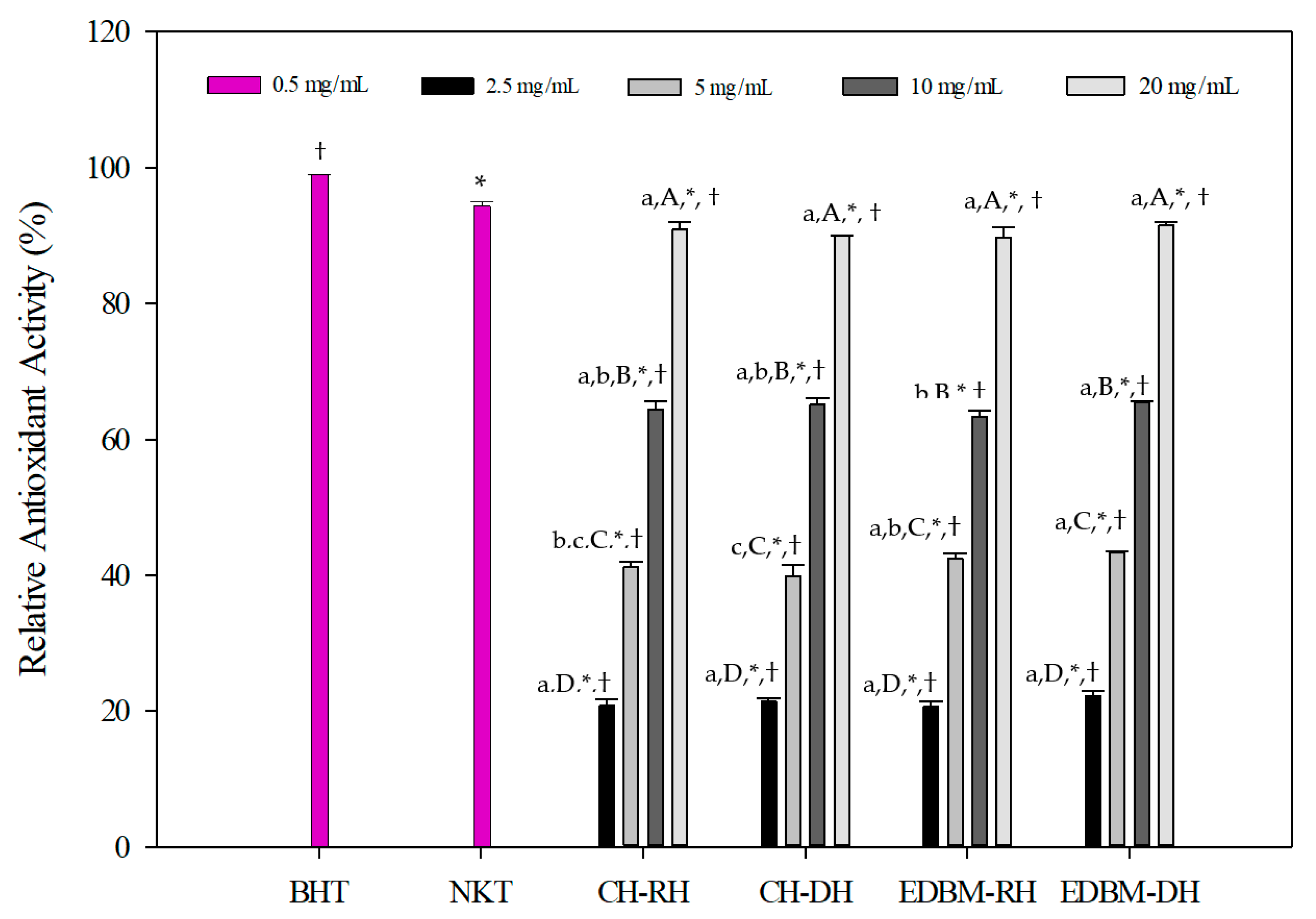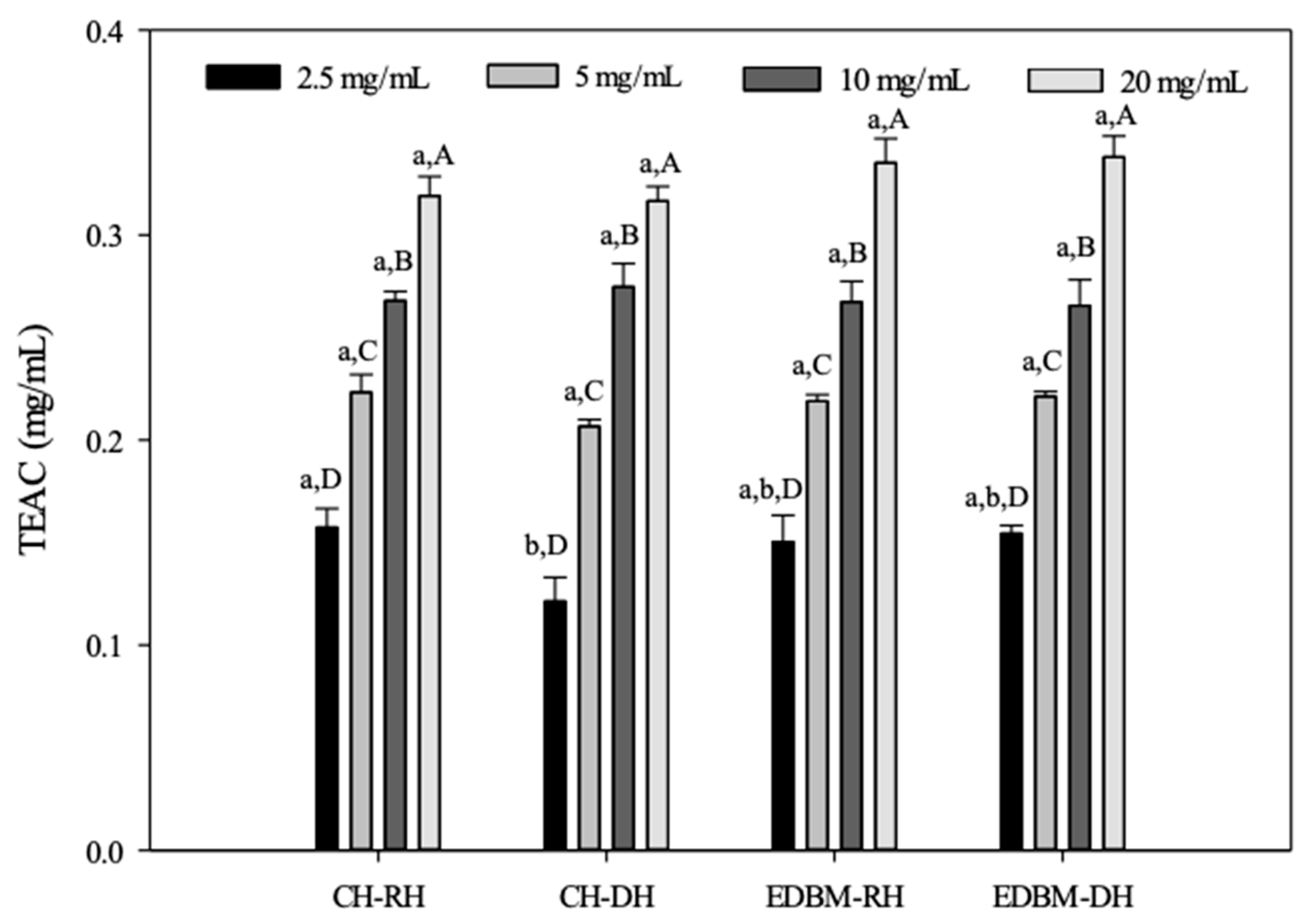Production of Demineralized Antibacterial, Antifungal and Antioxidant Peptides from Bovine Hemoglobin Using an Optimized Multiple-Step System: Electrodialysis with Bipolar Membrane
Abstract
:1. Introduction
2. Materials and Methods
2.1. Materials
2.2. Production of Hemoglobin Hydrolysates Using EDBM
2.2.1. Electrodialysis Cell
2.2.2. Preparation of Bovine Hemoglobin Demineralized Hydrolysate (EDBM-RH)
2.2.3. Preparation of Bovine Hemoglobin Discolored-Demineralized Hydrolysate (EDBM-DH)
2.3. Production of Hemoglobin Hydrolysate Using the Conventional Method
2.4. Antibacterial Activity
2.4.1. Agar Diffusion Method
2.4.2. Minimum Inhibitory Concentration (MIC)
2.5. Antifungal Activity
2.5.1. Agar Diffusion Method
2.5.2. Minimum Inhibitory Concentration (MIC)
2.6. Antioxidant Activity
2.6.1. Antioxidant Assay Using the β-Carotene Bleaching Method
2.6.2. Antioxidant Assay Using DPPH Radical Scavenging Capacity
2.6.3. Antioxidant Assay Using ABTS Radical Scavenging Capacity
2.6.4. Evaluation of Total Antioxidant Capacity
2.7. Statistical Analyses
3. Results and Discussion
3.1. Antibacterial Activity
3.1.1. Agar Diffusion Method
3.1.2. Minimum Inhibitory Concentration (MIC)
3.2. Antifungal Activity
3.2.1. Agar Diffusion Method
3.2.2. MIC and MFC of Bovine Hemoglobin Hydrolysates
3.3. Antioxidant Activity
3.3.1. Antioxidant Assay Using β-Carotene Bleaching
3.3.2. DPPH Radical Scavenging Capacity
3.3.3. Antioxidant Property Products by ABTS Assay
3.3.4. Evaluation of Total Antioxidant Capacity
4. Conclusions
Author Contributions
Funding
Data Availability Statement
Acknowledgments
Conflicts of Interest
Abbreviations
| ED | Electrodialysis |
| EDBM | Electrodialysis with Bipolar Membranes |
| Hb | Hemoglobin |
| CH-RH | Raw Hydrolysates (RH) produced by conventional hydrolysis (CH) |
| CH-DH | Discolored Hydrolysates (DH) produced by conventional hydrolysis (CH) |
| EDBM-RH | Raw Hydrolysates (RH) produced by EDBM |
| EDBM-DH NKT | Discolored Hydrolysates (DH) produced by EDBM Neokyotorphin |
| BHT | Butylated hydroxytoluene |
References
- Holban, A.-M.; Grumezescu, A.-M. Microbial contamination and food degradation. In Handbook of Food Bioengineering; Academic Press: Cambridge, MA, USA, 2018; Volume 10. [Google Scholar]
- Melsungen, B. Microbiological Contamination: Risk Prevention in Infusion Therapy. 2011. Available online: http://www.bbraun.lv/documents/microbiologicalcontamination.pdf (accessed on 2 April 2022).
- Wirtanen, G.; Salo, S. Microbial contaminants & contamination routes in food industry. In VTT Symposium; VTT Technical Research Centre of Finland: Espoo, Finland, 2007; Volume 248. [Google Scholar]
- Pitt, J.I.; Hocking, A.D. Fungi and Food Spoilage; Springer Science & Business Media: New York, NY, USA, 2009. [Google Scholar]
- Halliwell, B. Effect of diet on cancer development: Is oxidative DNA damage a biomarker. Free Radic. Biol. Med. 2002, 32, 968–974. [Google Scholar] [CrossRef]
- Stadtman, E.R. Protein oxidation and aging. Free Radic. Res. 2006, 40, 1250–1258. [Google Scholar] [CrossRef] [PubMed] [Green Version]
- Brul, S.; Coote, P. Preservative agents in foods. Int. J. Food Microbiol. 1999, 50, 1–17. [Google Scholar] [CrossRef]
- Bah, C.S.F.; Bekhit, A.E.-D.A.; Carne, A.; McConnell, M.A. Slaughterhouse blood: An emerging source of bioactive compounds. Compr. Rev. Food Sci. Food Saf. 2013, 12, 314–331. [Google Scholar] [CrossRef]
- Lafarga, T.; Hayes, M. Bioactive peptides from meat muscle and byproducts: Generation, functionality and application as functional ingredients. Meat Sci. 2014, 98, 227–239. [Google Scholar] [CrossRef]
- Przybylski, R.; Firdaous, L.; Châtaigné, G.; Dhulster, P.; Nedjar, N. Production of an antimicrobial peptide derived from slaughterhouse by-product and its potential application on meat as preservative. Food Chem. 2016, 211, 306–313. [Google Scholar] [CrossRef]
- Abou-Diab, M.; Thibodeau, J.; Deracinois, B.; Flahaut, C.; Fliss, I.; Dhulster, P.; Bazinet, L.; Nedjar, N. Bovine hemoglobin enzymatic hydrolysis by a new ecoeffcient process-Part II: Production of bioactive peptides. Membranes 2020, 10, 268. [Google Scholar] [CrossRef]
- Abou-Diab, M.; Thibodeau, J.; Deracinois, B.; Flahaut, C.; Fliss, I.; Dhulster, P.; Nedjar, N.; Bazinet, L. Bovine hemoglobin enzymatic hydrolysis by a new ecoeffcient process-Part I: Feasibility of electrodialysis with bipolar membrane and production of neokyotorphin (α137-141). Membranes 2020, 10, 257. [Google Scholar] [CrossRef]
- Abou-Diab, M.; Thibodeau, J.; Fliss, I.; Dhulster, P.; Nedjar, N.; Bazinet, L. Eco-circular production of demineralized bioactive peptides from bovine hemoglobin by performing the necessary steps simultaneously using Bipolar Membrane Electrodialysis. ACS Sustain. Chem. Eng. 2021, 9, 16905–16917. [Google Scholar] [CrossRef]
- Borch, E.; Arinder, P. Bacteriological safety issues in red meat and ready to-eat meat products, as well as control measures. Meat Sci. 2002, 62, 381–390. [Google Scholar] [CrossRef]
- Catiau, L.; Traisnel, J.; Delval-Dubois, V.; Chihib, N.-E.; Guillochon, D.; Nedjar- Arroume, N. Minimal antimicrobial peptide sequence from hemoglobin alpha chain: KYR. Peptides 2011, 32, 633–638. [Google Scholar] [CrossRef]
- Adje, E.Y. Hydrolyse Ménagée de L’hémoglobine Bovine par la Pepsine Porcine en Mélanges Hydroalcooliques et Obtention D’une Nouvelle Famille de Peptides Antimicrobiens; Lille University: Lille, France, 2010. [Google Scholar]
- Pfaller, M.A.; Sheehan, D.J.; Rex, J.H. Determination of fungicidal activities against yeasts and molds: Lessons learned from bactericidal testing and the need for standardization. Clin. Microbiol. Rev. 2004, 17, 268–280. [Google Scholar] [CrossRef] [Green Version]
- Koleva, I.I.; van Beek, T.A.; Linssen, J.P.H.; de Groot, A.; Evstatieva, L.N. Sreening of plant extracts for antioxidant activity: A comparative study on three testing methods. Phytochem. Anal. 2002, 13, 8–17. [Google Scholar] [CrossRef]
- Bersuder, P.; Hole, M.; Smith, G. Antioxidants from a heated histidine glucose model system. I: Investigation of the antioxidant role of histidine and isolation of antioxidants by high performance liquid chromatography. J. Am. Oil Chem. Soc. 1998, 75, 181–187. [Google Scholar] [CrossRef]
- Gulcin, I. Antioxidant properties of resveratrol: A structure-activity insight. Innov. Food Sci. Emerg. Technol. 2010, 11, 210–218. [Google Scholar] [CrossRef]
- Maisuthisakul, P.; Pongsawatmanit, R.; Gordon, M.H. Characterisation of the phytochemicals and antioxidant properties of extracts from Teaw (Cratoxylum formosum Dyer). Food Chem. 2007, 100, 1620–1629. [Google Scholar] [CrossRef]
- Re, R.; Pellegrini, N.; Proteggente, A.; Pannala, A.; Yang, M.; Rice-Evans, C. Antioxidant activity applying an improved ABTS radical cation decolorization assay Free Radical. Biol. Med. 1999, 26, 1231–1237. [Google Scholar]
- Prieto, P.; Pineda, M.; Aguilar, M. Spectrophotometric quantitation of antioxidant capacity through the formation of a phosphomolybdenum complex: Specific application to the determination of vitamin E. Anal. Biochem. 1999, 269, 337–341. [Google Scholar] [CrossRef]
- Zouari, O.; Przybylski, R.; Hannioui, M.; Sion, L.; Pascal Dhulster, P.; Nedjar Arroume, N. High added-value co-product: The porcine cruor is an attractive source of active peptides. Rev. J. Nutr. 2020, 7, 1–9. [Google Scholar]
- Yeaman, M.-R.; Yount, N.-Y. Mechanisms of antimicrobial peptide action and resistance. Pharmacol. Rev. 2003, 55, 27–55. [Google Scholar] [CrossRef] [Green Version]
- Van der Weerden, N.-L.; Bleackley, M.-R.; Anderson, M.-A. Properties and mechanisms of action of naturally occurring antifungal peptides. Cell. Mol. Life Sci. 2013, 70, 3545–3570. [Google Scholar] [CrossRef]
- Bahar, A.-A.; Dacheng Ren, D. Antimicrobial Peptides. Pharmaceuticals 2013, 6, 1543–1575. [Google Scholar] [CrossRef] [Green Version]
- Kumar, P.; Kizhakkedathu, J.-N.; Straus, S.-K. Antimicrobial Peptides: Diversity, Mechanism of Action and Strategies to Improve the Activity and Biocompatibility In Vivo. Biomolecules 2018, 8, 4. [Google Scholar] [CrossRef] [Green Version]
- Moosmann, B.; Behl, C. Cytoprotective antioxidant function of tyrosine and tryptophan residues in transmembrane proteins. Eur. J. Biochem. 2000, 267, 5687–5692. [Google Scholar] [CrossRef] [Green Version]
- Stadtman, E.R.; Levine, R.L. Free radical-mediated oxidation of free amino acids and amino acid residues in proteins. Amino Acids 2003, 25, 207–218. [Google Scholar] [CrossRef]
- Kim, S.-Y.; Je, J.-Y.; Kim, S.-K. Purification and characterization of antioxidant peptide from hoki (Johnius belengerii) frame protein by gastrointestinal digestion. J. Nutr. Biochem. 2007, 18, 31–38. [Google Scholar] [CrossRef]







| Bacteria Strains | Bovine Hemoglobin Hydrolysates | |||
|---|---|---|---|---|
| CH-RH | CH-DH | EDBM-RH | EDBM-DH | |
| Staphylococcus aureus | +++ | +++ | ++ | +++ |
| Listeria monocytogenes | ++ | ++ | ++ | ++ |
| Micrococcus luteus | + | + | + | + |
| Kocuria rhizophila | +++ | +++ | ++ | +++ |
| Escherichia coli | + | + | + | + |
| Salmonella newport | + | + | + | + |
| Bacteria Strains | Bovine Hemoglobin Hydrolysates | |||
|---|---|---|---|---|
| MIC | ||||
| CH-RH | CH-DH | EDBM-RH | EDBM-DH | |
| mg/mL | mg/mL | mg/mL | mg/mL | |
| Staphylococcus aureus | 0.31 ± 0.0 b | 0.31 ± 0.0 b | 1.25 ± 0.0 a | 0.31 ± 0.0 b |
| Listeria monocytogenes | 1.25 ± 0.0 b | 2.5 ± 0.0 a | 2.5 ± 0.0 a | 2.5 ± 0.0 a |
| Micrococcus luteus | 5 ± 0.0 b | 5 ± 0.0 b | 10 ± 0.0 a | 10 ± 0.0 a |
| Kocuria rhizophila | 0.31 ± 0.0 b | 0.31 ± 0.0 b | 0.62 ± 0.0 a | 0.31 ± 0.0 b |
| Escherichia coli | 10 ± 0.0 a | 10 ± 0.0 a | 10 ± 0.0 a | 10 ± 0.0 a |
| Salmonella newport | 5 ± 0.0 b | 10 ± 0.0 a | 10 ± 0.0 a | 10 ± 0.0 a |
| Bovine Hemoglobin Hydrolysates (mg/mL) | ||||||||||||
|---|---|---|---|---|---|---|---|---|---|---|---|---|
| CH-RH | CH-DH | EDBM-RH | EDBM-DH | |||||||||
| Fungal Strain | MIC | MFC | MFC/MIC | MIC | MFC | MFC/MIC | MIC | MFC | MFC/MIC | MIC | MFC | MFC/MIC |
| Paecilomyces spp. | 0.44 ± 0.0 b | 0.44 ± 0.0 C | 1 | 0.44 ± 0.0 b | 0.44 ± 0.0 C | 1 | 0.89 ± 0.0 a | 0.89 ± 0.0 B | 1 | 0.44 ± 0.0 b | 1.78 ± 0.0 A | 4 |
| Aspergillus niger | 7.15 ± 0.0 a | 0.0 ± 0.0 A | ND | 7.15 ± 0.0 a | 0.0 ± 0.0 A | ND | 7.15 ± 0.0 a | 0.0 ± 0.0 A | ND | 7.15 ± 0.0 a | 0.0 ± 0.0 A | ND |
| Rhodotorula mucilaginosa | 0.89 ± 0.0 c | 1.78 ± 0.0 C | 2 | 1.78 ± 0.0 b | 7.15 ± 0.0 B | 4 | 3.57 ± 0.0 a | 14.3 ± 0.0 A | 4 | 1.78 ± 0.0 b | 7.15 ± 0.0 B | 4 |
| Mucor racemosus | 3.57 ± 0.0 b | 7.15 ± 0.0 A | 2 | 3.57 ± 0.0 b | 3.57 ± 0.0 B | 1 | 7.15 ± 0.0 a | 7.15 ± 0.0 A | 1 | 3.57 ± 0.0 b | 7.15 ± 0.0 A | 2 |
| Penicillium crustosum | 7.15 ± 0.0 a | 0.0 ± 0.0 A | ND | 7.15 ± 0.0 a | 0.0 ± 0.0 A | ND | 7.15 ± 0.0 a | 0.0 ± 0.0 A | ND | 7.15 ± 0.0 a | 0.0 ± 0.0 A | ND |
| DPPH | CH-RH | CH-DH | EDBM-RH | EDBM-DH | NKT | Trolox |
|---|---|---|---|---|---|---|
| IC50 (mg/mL) | 2.52 ± 0.01 b | 2.77 ± 0.03 a | 2.39 ± 0.09 c | 2.29 ± 0.04 d | 0.58 ± 0.02 e | 0.36 ± 0.01 f |
| TEAC | 0.14 ± 0.002 d | 0.13 ± 0.005 e | 0.15 ± 0.001 c | 0.15 ± 0.003 c | 0.64 ± 0.01 b | 1 a |
| ABTS | CH-RH | CH-DH | EDBM-RH | EDBM-DH | NKT | Trolox |
|---|---|---|---|---|---|---|
| IC50 (mg/mL) | 3.91 ± 0.02 b | 4.00 ± 0.02 a | 3.54 ± 0.01 c | 3.43 ± 0.02 d | 0.56 ± 0.02 e | 0.50 ± 0.02 f |
| TEAC | 0.12 ± 0.004 d | 0.12 ± 0.005 d | 0.14 ± 0.005 c | 0.14 ± 0.005 c | 0.89 ± 0.03 b | 1 a |
Publisher’s Note: MDPI stays neutral with regard to jurisdictional claims in published maps and institutional affiliations. |
© 2022 by the authors. Licensee MDPI, Basel, Switzerland. This article is an open access article distributed under the terms and conditions of the Creative Commons Attribution (CC BY) license (https://creativecommons.org/licenses/by/4.0/).
Share and Cite
Abou-Diab, M.; Thibodeau, J.; Fliss, I.; Dhulster, P.; Bazinet, L.; Nedjar, N. Production of Demineralized Antibacterial, Antifungal and Antioxidant Peptides from Bovine Hemoglobin Using an Optimized Multiple-Step System: Electrodialysis with Bipolar Membrane. Membranes 2022, 12, 512. https://doi.org/10.3390/membranes12050512
Abou-Diab M, Thibodeau J, Fliss I, Dhulster P, Bazinet L, Nedjar N. Production of Demineralized Antibacterial, Antifungal and Antioxidant Peptides from Bovine Hemoglobin Using an Optimized Multiple-Step System: Electrodialysis with Bipolar Membrane. Membranes. 2022; 12(5):512. https://doi.org/10.3390/membranes12050512
Chicago/Turabian StyleAbou-Diab, Mira, Jacinthe Thibodeau, Ismail Fliss, Pascal Dhulster, Laurent Bazinet, and Naima Nedjar. 2022. "Production of Demineralized Antibacterial, Antifungal and Antioxidant Peptides from Bovine Hemoglobin Using an Optimized Multiple-Step System: Electrodialysis with Bipolar Membrane" Membranes 12, no. 5: 512. https://doi.org/10.3390/membranes12050512
APA StyleAbou-Diab, M., Thibodeau, J., Fliss, I., Dhulster, P., Bazinet, L., & Nedjar, N. (2022). Production of Demineralized Antibacterial, Antifungal and Antioxidant Peptides from Bovine Hemoglobin Using an Optimized Multiple-Step System: Electrodialysis with Bipolar Membrane. Membranes, 12(5), 512. https://doi.org/10.3390/membranes12050512








